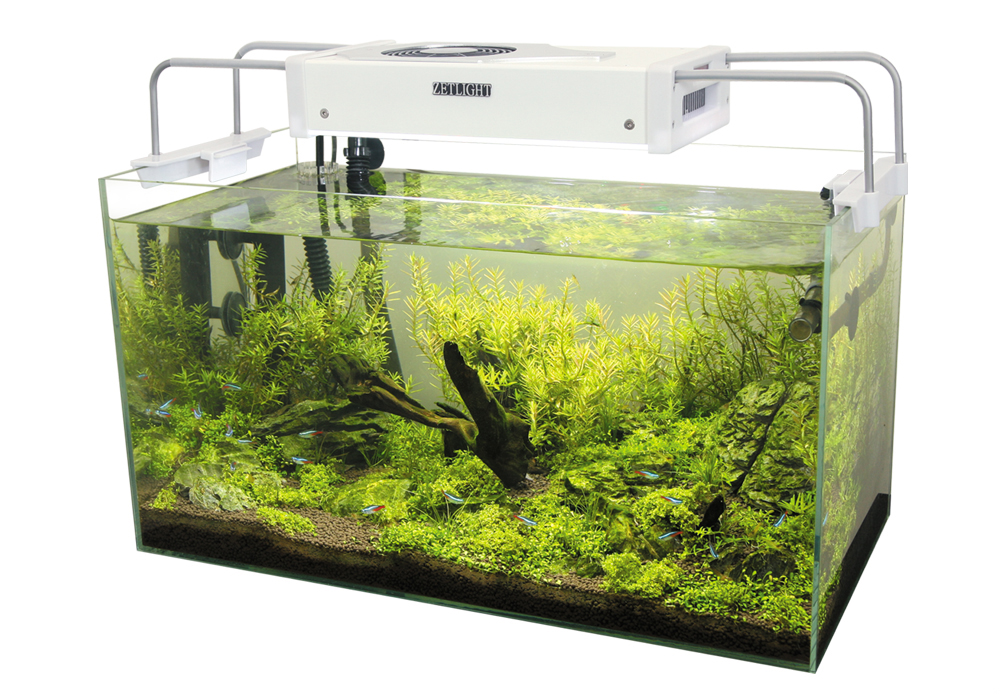The intent of this post is to give basic answers to the most frequent questions we get about selecting lighting in both fresh- and saltwater tanks, with focus on newcomers, but also with recommendations and details for more enhanced reef saltwater and planted freshwater aquarium owners.
Lighting is an essential part of both freshwater and reef aquariums. It can make a huge difference in how natural your tank looks, and also brown diatom algae is usually a problem in freshwater tanks with poor lighting that has operated for some time.
There are also some facts that show if good lighting aids in perfect Redox that is a water parameter that has a certain effect on fish health. Human studies in the lighting show that lighting that has similar PAR & PUR required by photosynthetic life is helpful for human health, so projecting this to a fish only tank is quite reasonable.
Aside from this, plants, reef, coral, etc., need the right lighting to do well. For these arguments, having the best light your aquarium maintaining budget can manage is hugely suggested. This, of course, can be challenging with the abundance of new lights now offered on the market, many of which have low energy properties, the many new LED options available today and so on.
There is a considerable difference in the lighting demands for fish only tanks and for planted tanks and, if you are not careful of these differences, you could be going over a big oversight. Aquarium fish have no biological need for light so the lighting needs for a fish only aquarium are somewhat lower than those for an aquarium with live plants. Planted freshwater tanks need at least 3 to 5 watts per gallon of tank volume to be able to prosper.
T5 and T8 lights come in the form of fluorescent tubes that are 5/8th inch to 1 inch in size and come in several outputs and lengths. It is based on the same kind of lights used in countless office and school buildings. The T5 tubes have many improvements to throw out the very bright light in precisely the right part of the spectrum that corals and plants require to flourish.
Table of Contents
T5 and T8 Pros:
- Readily available everywhere.
- Cheap – most affordable type of lighting.
- The light transmitted gives great viewing and a perfect aid for plant growth.
- A variety of aquarium lights are offered for all types of aquariums.
T5 and T8 Cons:
- T5 and T8 can release too much heat, so a heat dissipation would be advised.
- It’s not as long-term as more current sources of lighting, so may need changing quite soon (average 8000 hours of the lifetime).
- The fluorescent lighting units actually emit a little bit of UV radiation.
The LED lighting is still relatively new but has been demonstrated to be economical and it’s used as a reliable lighting source. If you do not wish to regularly change your fluorescent bulbs or take care of fluorescent lights periodically, then LED is your ideal solution. Tank LED lights have a significantly lengthier life than fluorescent tubes. Since LEDs only use a little energy, they are very economical and will need less cooling parts to deal with the heat they generate.
If you decide on to use LEDs, you may want to use a few source points to ensure that the light distributes evenly inside the aquarium and offers a proper focus for the whole aquarium.
LED Pros:
- Energy economical.
- Lengthy life can operate for a very long time.
- Minimal heat dissipation, no need to cool it separately.
- Offered in different colors, enhancing the colors of your fish and decorations.
- Light from LEDs can penetrate deeper into the bottom part of the tank.
LED Cons:
- Compared to other kinds of lighting, it can be pricey at the beginning. But over a longer time period, the low running costs counter-balance the first cost.
Unsurprisingly, every type of lighting source has its benefits and shortcomings. As a standard rule, lighting should imitate the sunlight found in the natural habitat of the habitats.
Having a lighting program cycle that imitates day and night is valuable for fish and other life because it helps to create a regimen, makes them feel safe and lets them rest.
For the best results, spend time investigating and planning to guarantee you can see your tank really in the best light.
Alex is fascinated with “understanding” people. It’s actually what drives everything he does. He believes in a thoughtful exploration of how you shape your thoughts, experience of the world.

